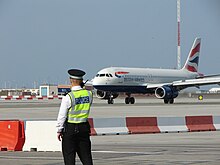British Airways plc (BA) is the flag carrier airline of the United Kingdom. It is headquartered in London, England, near its main hub at Heathrow Airport.
Gibraltar has a limited public transport system, due to the compact size of the territory.
Virgin Atlantic, a trading name of Virgin Atlantic Airways Limited and Virgin Atlantic International Limited, is a British airline with its head office in Crawley, West Sussex, England. The airline was established in 1984 as British Atlantic Airways, and was originally planned by its co-founders Randolph Fields and Alan Hellary to fly between London and the Falkland Islands. Soon after changing the name to Virgin Atlantic Airways, Fields sold his shares in the company after disagreements with Richard Branson over the management of the company. The maiden flight from London–Gatwick to Newark took place on 22 June 1984.
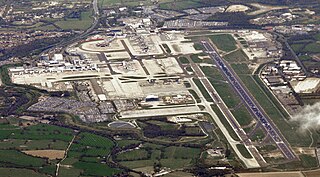
London Gatwick, also known as Gatwick Airport, is the secondary international airport serving London, England, United Kingdom. It is located near Crawley, West Sussex, England 29.5 miles (47.5 km) south of Central London. In 2022, Gatwick was the second-busiest airport by total passenger traffic in the UK, after Heathrow Airport, and was the 8th-busiest in Europe by total passenger traffic. It covers a total area of 674 hectares.
British Midland Airways Limited was an airline in the United Kingdom with its head office in Donington Hall in Castle Donington, close to East Midlands Airport, England. The airline flew to destinations in Europe, the Middle East, Africa, North America and Central Asia from its main hub at Heathrow Airport, where at its peak it held about 13% of all takeoff and landing slots and operated over 2,000 flights a week. BMI was a member of Star Alliance from 1 July 2000 until 20 April 2012.
BA Connect was a wholly-owned subsidiary airline of British Airways. It was headquartered in Didsbury, Manchester, England, it operated a network of domestic and European services from a number of airports in the United Kingdom on behalf of British Airways. The airline operated as a low-cost carrier, with food sold via a 'buy on board' programme.
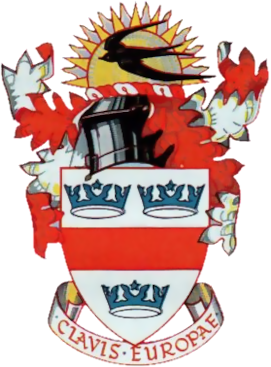
British European Airways (BEA), formally British European Airways Corporation, was a British airline which existed from 1946 until 1974.
British Caledonian (BCal) was a British private independent airline which operated from London Gatwick Airport in south-east England during the 1970s and 1980s. It was created as an alternative to the British government-controlled corporation airlines and was described as the "Second Force" in the 1969 Edwards report. It was formed by the UK's second-largest, independent charter airline Caledonian Airways taking over British United Airways (BUA), then the largest British independent airline and the United Kingdom's leading independent scheduled carrier. The carrier slogan was Let's go British Caledonian in the 1970s and We never forget you have a choice in the 1980s. The BUA takeover enabled Caledonian to realise its long-held ambition to transform itself into a scheduled airline. The merged entity eventually became the UK's foremost independent, international scheduled airline.
CityFlyer Express was a short-haul regional airline with its head office in the Iain Stewart Centre next to London Gatwick Airport in England.

Gibraltar International Airport, previously known as North Front Airport, is the civilian airport that serves the British overseas territory of Gibraltar. The runway and aerodrome is owned by the Ministry of Defence (MoD), and operated by the Royal Air Force (RAF) as RAF Gibraltar. Civilian operators use the civilian-operated terminal. National Air Traffic Services (NATS) hold the contract for provision of air navigation services at the airport.
The Bland Group Ltd. is made up of a number of small and medium-sized operating companies based in Gibraltar, the United Kingdom and Morocco.

British Eagle International Airlines was a major British independent airline that operated from 1948 until it went into liquidation in 1968. It operated scheduled and charter services on a domestic, international and transatlantic basis over the years.
British Caledonian (BCal) came into being in November 1970 when the Scottish charter airline Caledonian Airways, at the time Britain's second-largest, wholly privately owned, independent airline, took over British United Airways (BUA), then the largest British independent airline as well as the United Kingdom's leading independent scheduled carrier.
British Airways CityFlyer is a British regional airline, and a wholly owned subsidiary of British Airways with its head office based in Didsbury, Manchester, England. It operates a network of domestic and European services from its base at London City Airport. All services operate with BA's full colours, titles and flight numbers. BA Cityflyer Limited holds a United Kingdom Civil Aviation Authority Type A Operating Licence, meaning that it is permitted to carry passengers, cargo and mail on aircraft with 20 or more seats.

British Airways Helicopters was a British helicopter airline from 1964 to 1986.
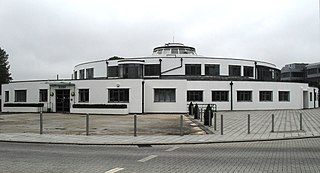
The Beehive is the original terminal building at Gatwick Airport, England. Opened in 1936, it became obsolete in the 1950s as the airport expanded. In 2008, it was converted into serviced offices, operated by Orega, having served as the headquarters of franchised airline GB Airways for some years before that. It was the world's first fully integrated airport building, and is considered a nationally and internationally important example of airport terminal design. The Beehive is a part of the City Place Gatwick office complex. The 20,000-square-foot (1,900 m2) former terminal building is on a 2-acre (0.81 ha) site.

British Airways (BA), the United Kingdom's national airline, was formed in 1974 with the merger of the two largest UK airlines, British Overseas Airways Corporation (BOAC) and British European Airways (BEA), and including also two smaller regional airlines, Cambrian Airways and Northeast Airlines. The merger was the completion of a consolidation process started in 1971 with the establishment of the British Airways Board, a body created by the British government to control the operations and finances of BOAC and BEA, which initially continued to exist as separate entities.
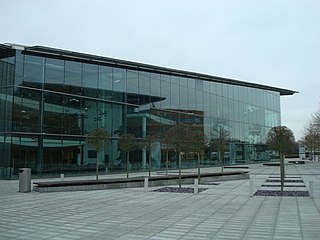
City Place Gatwick is an office complex located on the property of London Gatwick Airport in Crawley, West Sussex, England. The complex includes four buildings: The Beehive, an approximately 20,000-square-foot (1,900 m2) former terminal building at Gatwick Airport located on a 2.0-acre (0.81 ha) site; 1 City Place a 131,500-square-foot (12,220 m2) facility on a 4.2-acre (1.7 ha) site, 2 City Place, a 85,000-square-foot (7,900 m2) building on a 1.9 acres (0.77 ha) plot, and 3 City Place, a 65,000-square-foot (6,000 m2) building on a 1.06-acre (0.43 ha) plot. Hamiltons Architects designed the L-shaped 3 City Place.
Gatwick Airport was in Surrey until 1974, when it became part of West Sussex as a result of a county boundary change. The original, pre-World War II airport was built on the site of a manor in the parish of Charlwood. The land was first used as an aerodrome in the 1920s, and in 1933 commercial flights there were approved by the Air Ministry.
BA EuroFlyer is a British airline, and a wholly owned subsidiary of British Airways. It operates a network of short haul services from its base at Gatwick Airport near London. All services operate with BA's full colours, titles and flight numbers.




